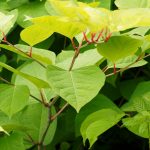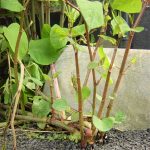Japanese Knotweed
Identification:
Japanese knotweed is a dense growing shrub reaching heights of 10 feet and with a look similar to bamboo. The semi-woody stem is hollow with enlarged nodes. Leaves are alternate, 6 inches long, 3-4 inches wide and broadly-ovate. Japanese knotweed commonly invades disturbed areas with high light, such as road sides, stream banks and shore lines, but can also grow in full shade conditions with a high drought tolerance, a high temperature tolerance and high salinity conditions.
The stands are so dense that they shade out other plant species, reducing wildlife habitat for native species. This plant is extremely hard to eradicate once established, so the key is preventing establishment by manually removing immature clusters. Along river banks, the shallow root growth can cause unstable banks, which is exacerbated by knotweed dying back in the fall.
Control:
Japanese knotweed has the ability to regrow full plants from its cuttings as well as from its rhizomes (root structure) and seeds. Due to this, knotweed cannot simply be cut down, but must be dug up with the entire root structure and disposed of fully. Plants should be removed from the site and either disposed of in black plastic bags. For more established populations, plants can be cut close to the ground and then covered with heavy duty, dark colored tarps to smother the root systems. This method can take around 5 years to be fully successful. The “cut-and-dab” or stem injection herbicide application can also be employed, with varied success rates.



